mobile View, to the German Version tap the flag


- Rhine Province (Rheinprovinz)
- former Prussian province
- in 1945 dissolved
• Flags
• Meaning/Origin of the Flag
• Coat of Arms
• Meaning/Origin of the Coat of Arms
• Map
• Numbers and Facts
• History
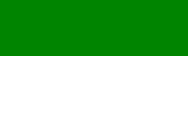
Colours of the country,
ratio = 3:5



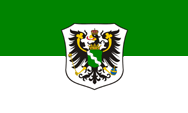
to 1926,
Official flag (doubtful),
ratio = 3:5



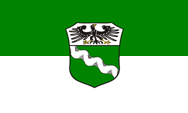
1926–1934,
Official flag (doubtful),
ratio = 3:5




The colours of the flag of the Rhine-Province, green and white, have their roots in the blazon of the Rhineland: white diagonal wave-line (the river Rhine) on green ground. The in the heraldry correct arrangement (above white and below green) was probably dismissed, to exclude confusions with the Kingdom of Saxony.
From 1875, the provinces of Prussia could largely operate in self-governing. There was a provincial parliament and a provincial government (Provincial Committee). Each province had its own colors (Landesfarben), which were also used as flag, and they had also their own coat of arms. If the provincial governments put for official purposes (official flag) their coats of arms on a flag with the provincial colors is not handed down beyond doubt and not for all provinces.
Another incident for the flag was the seizure of power by the National Socialists in the German Empire in 1933. All official non-swastika flags, that refered to federalism, regional references or the old German Empire were abolished between 1933 and 1935. For the National Socialists, the federal structure of the German Empire, its historically grown countries, was considered as outdated, as relics of a past to be overcome. In this sense, several laws were enacted, on 31st of March in 1933 the 'Provisional Law for the phasing of the countries with the Empire', on 7th of April 1933 the 'Second Law for the phasing of the countries with the Empire' and finally, on 30th January in 1934 the 'Law on the rebuilding of the empire'. Thus, the federal structure of the German Empire was replaced by the gau-structure of the NSDAP, the countries became meaningless. From now on, offices and authorities had to use the swastika flag as official flag, until September 15th in 1935, when by the flag-law was legislated a new created official flag for all the offices and authorities of the empire. The prime ministers of the countries, which latest in 1933 all came from the NSDAP – now mostly called Reichsstatthalter (maybe translated as 'governor') – however remained in office until 1945. This was then also applied on the provinces of the state of Prussia. Their sovereign duties were taken over by the Gau structure of the NSDAP, which sometimes coincided with the borders of the provinces and sometimes they were new created. The respective provincial flags disappeared. The corresponding country colours continued, with restrictions, but definitly not in the form of flags. They were used, for example, occasionally on uniforms of the SA or in some ranks of the Hitler Youth in the breast cord.
After the war, the administration within the German Empire was rebuilt, but locally, following the structure of the countries. These have been partly old countries, and some new countries were created. Sometimes they bethought the old country colours and reactivated them – or they created new ones – for limited sovereign duties, which were under the control of the Allies. With the founding of the FRG and the GDR, an internal country-structure was finalised for both entities and corresponding official flags were introduced for these countries.
The Rhineland Regional Association, founded in 1953 (it unites the administrative districts of Düsseldorf, Cologne, Arnsberg, Detmold and Münster), took over coat of arms and flag of the Rhine Province.
Source: Volker Preuß,
Jürgen Kaltschmitt,
Uniform-Fibel


1864–1926, Coat of arms of the Rhine Province,
Source, by: Deutsche Wappen Rolle
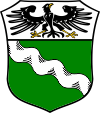
1926–1945, Coat of arms of the Rhine Province,
Source, by: Wikipedia (D)

The coat of arms of the Rhine Province goes back to the Grand Duchy of Lower Rhine, created in 1817. It was taken over in 1822 for the newly created Rhine Province. It shows the Prussian eagle with a breast shield that shows a white, wavy river course on a green background and is intended to symbolize the course of the River Rhine through the green Rhineland. In 1864 a crown was added to the eagle's breastplate. In the period after the fall of the monarchy (1918), a new coat of arms was not introduced until 1926. It is divided and now shows the Prussian eagle in the head of the shield, and underneath, in the main field, the image of the former breast shield, the course of the river on a green background. The Rhineland Regional Association (Landschaftsverband), founded in 1953 (it unites the administrative districts of Düsseldorf, Cologne, Arnsberg, Detmold and Münster), took over coat of arms and flag of the Rhine Province.
Source: Wikipedia (D),
Deutsche Wappen Rolle,
Volker Preuß

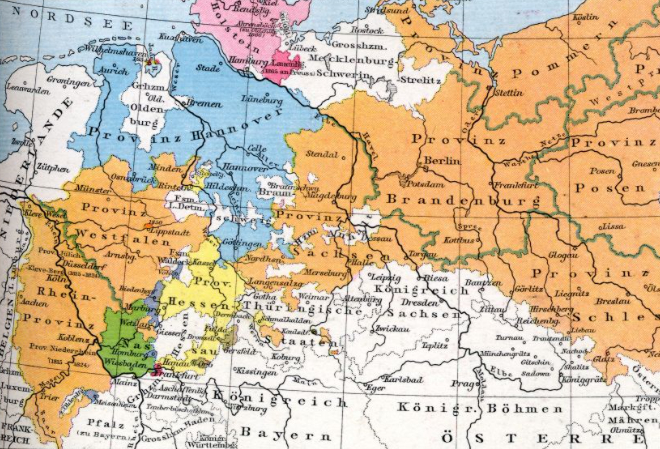
Source:
Professor G. Droysens Allgemeiner Historischer Handatlas, 1886
The historical map from 1866 shows the Rhine province in the far west.

Area: 9.256 square miles
Inhabitants: 7.257.000 (1925)
Density of Population: 784 inh./sq.mi.
Capital: Koblenz
Source: www.gonschior.de

The Rhine Province was formed in 1822 by unification of the since the
Congress of Vienna (1815) existing Prussian Provinces of Kleve, Berg, Lower
Rhine and Kurtrier. Further territories have been affiliated later. The
Rhine Province was dissolved in 1945 (whole Prussia was abolished by the
Allies in 1947), and distributed in new – by the allies created – German countries,
(Rhineland-Palatinate,
and Northrhine-Westfalia).
Source: Wikipedia (D)







![]()








